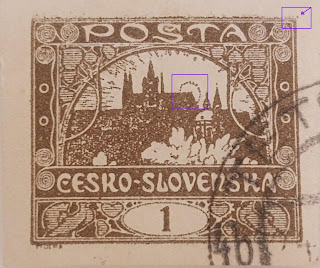In 1918-1920 there was little time to print stamps for the newly formed country Czechoslovakia.
The Austrian-Hungarian empire was dissolved after the first World War, and new countries were formed. This included the need for own stamps. Due to the urge for stamps, many of the early printings were defective or at least with lots of irregularities.
The Czech Hradčany stamps can keep one busy for hours. With a bit of
patience, you will easily find little (or large) flaws on the stamps.
Plate I, position 87
 |
| Plate I, position 87 |
Two flaws determinate the position on the sheet.
At first, we find an ink spot in the C of CESKO.
 |
| Plate I, pos 87, spot in C |
The second mark, is right of the left branch. There we see a spot that is not suppposed to be there.
 |
| Plate I, pos 87, spot next to branch |
With only two clear flaws, it might be difficult to find a copy, if the postal cancellation is hiding them.
The second Hradčany stamp is from plate II.
Plate II, position 03:
 |
| Plate II, position 03 |
At first, there is a small dot, outside the north east frame corner.
This is only visible with a nicely cut stamp with wide borders.
 |
| spot in the N-E corner |
After lots of printing on this plate, the image became more and more blurred.
Not only the spot in the corner is visible, there are also multiple spots above the frame in general.
On early copies, only the corner spot is determinating for the position.
The second 'flaw' is much cooler.
Here, the sun is not round but egg-shaped.
 |
| egg-shaped sun |
 |
| 'normal' sun |
 |
| 'ovoid' sun |
In the 'normal' sun, this gap is about halfway the diameter of the sun.
Compared to the 'ovoid' sun, the dots of the sun's border stop more or less at the small gap in the roof.
When comparing both versions, we clearly see the 'normal' sun is way closer to the 4th tower.
By the way the sun on the design, was never 'normal'.
According the design, this sun is rising in the west, Mucha took some 'artistic liberty' (or was it the sunset instead?).
In later designs, the sun was omitted.
to be continued ...
No comments:
Post a Comment